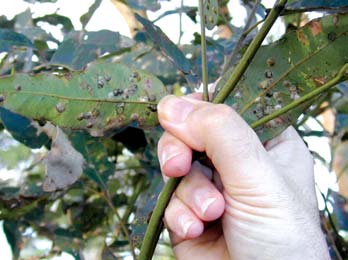PESTS AND DISEASES OF FORESTRY IN NEW ZEALAND
Eradication not viable for new pests
From Biosecurity Issue 38, September 2002.

Routine MAF risk site inspections of the Auckland Airport surrounds have resulted in two new insects (psyllids) being found on Eucalyptus botryoides trees.
The psyllids are native to Australia and have been identified as the lerp-forming species Creiis lituratus and a free living psyllid Anoeconeossa communis, found in association with C. lituratus making use of its lerps for shelter and protection (see sidebar). Both psyllids are host specific to Eucalypts.
C. lituratus is a known pest species in Australia where it causes significant damage to some commercial eucalyptus species like E. dunnii.
Psyllids, or jumping plant lice, belong in the family Psyllidae. The immature stages (nymphs) and adults suck the plant juices from their hosts.
Many species (including Creiis) construct protective coverings (lerps) under which the insect feeds. The lerps are largely formed from honeydew which is the sugary fluid that these insects excrete.
Feeding by these insects kills leaf tissue and severe infestations can result in extensive damage to foliage. An initial follow up survey carried out in early July, to a five kilometre radius around the point of first interception, resulted in the detection of a further six infested trees. From the survey results it appears that the population identified in Auckland represents the remains of a generation grown up over the last summer as most adults had dispersed and only a few early instars were present.
A group of technical experts and forestry industry representatives met in early August and agreed that both species are now too widely dispersed for eradication to be an option. In any case, available insecticide sprays have limited efficacy and are too toxic to be used in urban environments.
On a more positive note, both species seem to have arrived accompanied by parasitoid species that could provide significant biological control.
MAF, after consultation with the advisory group, has opted to:
- get better information on the biology of these two psyllids
- fully identify the parasites so as to get a better idea of likely control they might provide; and
- collect more information on the full range of eucalypt species likely to be affected.
In Australia, the main impact is on E. dunnii, a species that is mainly grown in New Zealand for ornamental purposes, but is closely related to the more widely grown E. nitens.
An information sheet on the pest will be developed by the technical group to alert nurserymen, wood lot owners, local government park staff and the like, on the need to spray eucalypt seedlings, so as to slow the rate of insect spread.
Davor Bejakovich, National Manager Forest Pest Surveillance and Response, Forest Biosecurity

 Farm Forestry New Zealand
Farm Forestry New Zealand

